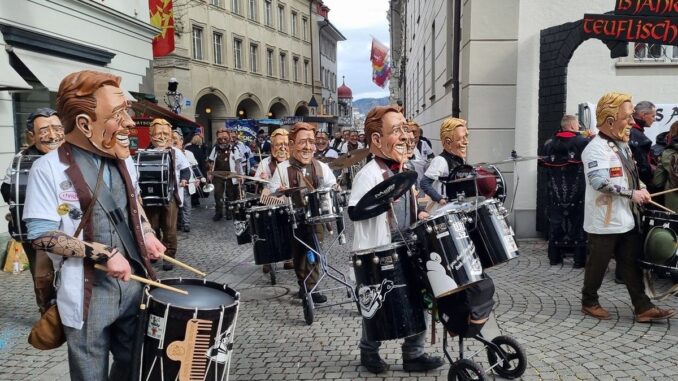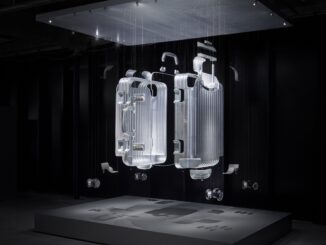
Mark Nicholls immerses himself in the colour and vibrancy of the Lucerne Carnival.
It is a little after 4.30am and the Chapel Square in Lucerne is packed with an anticipatory crowd.
They are awaiting the Big Bang.
This colossal blast – when it comes at 5am on the dot – reverberates across the Swiss city, momentarily turning night into daylight and signalling the start of the Lucerne Carnival.
It unleashes a wave of euphoria that will go on for days, combined with bizarre ceremonials, joviality, food and drink and even a darker element of ghoulish masks and dramatic costumes.
Fifth season
In Lucerne, they call Carnival the “fifth season.”
A fiercely Catholic community, it has its origins in the Middle Ages when the Church rigidly imposed the frugal practices.
Citizens traditionally used up food stocks and embarked on a period of indulgence before starting the fasting and self-sacrifice of Lent.
The ceremonials also reflect a Lucerne victory in the Old Zurich War of 1446 – a story told through the imaginary characters of Brother Fritschi and his family.
A yet further layer is the Celtic custom of driving away the winter spirits with terrifying masks, shaggy costumes and loud music, while welcoming in fertile spring. However, the irony of this premature driving away of winter in Switzerland, given the scarcity of snow in ski resorts during 2024, seemingly remained unspoken.
While the religious undertones may be missed by those just out for a good time, the origins of the carnival are steeped in history, mythology and some good old-fashioned storytelling.

Drum and brass
That comes to life in early February when thousands of revellers pour onto the streets, dress up in lurid costumes and disturbing masks to be entertained by the irresistible drumbeats and brass cacophony of the Guggen bands.
A Swiss institution, each Guggen band is led by a conductor and has an individuality and identity often linked to workplace or community.
A series of drummers pushing portable kits are followed by brass sections of trumpets, trombones, horns, tubas and sousaphones, blasting out anthems such as Sweet Caroline, Abba classics and traditional Swiss melodies with unrestrained rhythmic vigour.
This is more drum and brass, rather than drum and bass, but techno has also found its place in this tsunami of noise and colour which is at the heart of the Lozärner Fasnacht (Lucerne Carnival) tradition.
Chaotic choreography
Organised by the guilds and merchant societies of Lucerne, the carnival runs to a strict timetable, an almost chaotic choreography that adds to the vibrancy of the launch and the days that follow.
The Big Bang (the Urknall) occurs on the lake at 5am on the Thursday morning – also known as ‘Fat Thursday’ – and is followed by the arrival of Bruder Fritschi (Brother Fritschi) and his family by boat, who then make their way to the Fritschi Fountain in Kapellplatz (Chapel Square).
The crowds meeting them are duly showered by millions of pieces of paper (from shredded phone books), signalling the official start of the carnival and the Guggenmusig.
The Fritschi family also symbolically throw oranges and sweets – for energy and succour – into the crowd before dispersing for a mass communal breakfast in the Town Hall.
From there, its party, party, party, throughout the day, and into the following week with the finale on Güdis (Shrove) Tuesday, ahead of Ash Wednesday when an air of silence and restraint returns to the city.

Ornate costumes
Over that time, thousands of masked carnival goers surge through Lucerne’s streets, cross the lake bridges and drink, sing, dance, mingle and let loose for hours on end.
Some promenade their costumes as groups in similar dress, others with individual designs; some are highly ornate and intricate; others downright scary.
Throughout the day, the various ensembles of Guggen musicians play at street corners and interchanges or in the open-air theatre on Sternenplatz in front of the Stadtkeller restaurant, while others march through the lanes of Lucerne, the drumming music resonating off the high buildings.
At 2pm a formal Fritschi parade of themed floats, bands and the Fristchi family sets off around the city. As darkness, falls the festivities continue, often right throughout the night.
Smaller ensembles
On that first night, the music and revelry goes on into the early hours, at some bars all night. Whether you are up and about, or staying in a hotel, don’t expect to get much sleep as the city remains a cacophony of sound.
In a more intimate turn, smaller ensembles break away to entertain diners, such as at the Restaurant Ente, Bistro du Théatre and Doorzögli, the Wilder Mann restaurant or Le Lapin.
After Fat Thursday, the festivities continue. The Wey parade happens on the Monday and the Monstercorso parade on Güdis Tuesday, all interspersed with informal performances, jam sessions and a chance to admire the creative costumes and floats.

Walls of sound
Drum and brass remain the soundtrack as performances go on throughout the six days, but little matches the unleashed exuberance of that first day.
The sheer energy of the performers is admirable.
Dario Egger is President of the Moles, a tunnellers’ Guugger band from Lucerne, and tells me after a performance in a narrow street:
“We love coming to the Lucerne Carnival. It is the friendship, it is about the whole atmosphere and playing and meeting other groups, we just have a great time.”
Dress in vivid orange tunnellers gear and mole masks with their mobile bar/coffee hut never far away, they expect to complete at least 15 performances through the day, as well as taking part in the formal parade as well as impromptu performances too.
Dario, who plays drums, adds:
“We’re up at 4am and the last performance will be after midnight or even later. It is so great to play in the streets, the resonance of the sound from the walls is fantastic.”
When they are not performing, the Monster-Guugger Band’s musicians undertake complex tunnelling processes for Swiss infrastructure projects.

Lively atmosphere
Tour guide Heidi Muffler has loved Lucerne Carnival since her childhood and still totally immerses herself in the story and ceremony behind it as well as the atmosphere that pervades through the city during the event.
She says:
“I love the carnival. I have been enjoying it since I was a child; it is the sound of the music, the atmosphere, everyone is dressed up, having fun and being exactly what they want to be.
“At the carnival we have fun, we drink and talk and for every age it has a special characteristic. It is a great event, very important to us, and when you are in the city during carnival you feel free with no reservations.”
However, not everyone enjoys the carnival and a significant numbers of Lucerne residents do tend to leave the city for the duration.
If noise and colour is not their scene, you can’t really blame them. Shops and businesses close also.
Heidi, who donned a distinctive official uniform with a sinister expression on the face of her mask for the 2024 event, adds:
“There are about 100 bands taking part, with about 4,000 musicians, so the music is everywhere.”
Lovely Lucerne
When the streets aren’t packed with revellers, Lucerne is a lovely city to wander around. The Chapel Bridge across the lake is a landmark and historic buildings rise above the waterside.
The iconic medieval bridge forms the centrepiece of the city and is one of the oldest covered wooden bridges in Europe. However, its famous bridge paintings are covered by wood panels for protection during carnival.
Other attractions, easily explored on foot, include the Museggmauer city wall, Hofkirche, Lion Monument and the various squares and churches in the old town, or you can take a boat trip on the lake and stop off at the Transport Museum.
Spending six days of carnival in Lucerne may be a big ask, but if you’re skiing in the region, it’s easy to reach the lakeside city by direct train from resorts such as Engelberg-Titlis to experience the event for a day or two.
Alternatively, Melchsee-Frutt is not far away either. It’s a smaller resort with character and the chance to try ice fishing on the frozen lake.
But if you do venture into Lucerne for the carnival, be prepared to be met by a wall of sound, a blaze of colour, and an atmosphere you’ll never forget.
Factbox:
Accommodation: Mark Nicholls stayed at the Wilden Mann Hotel in Lucerne.
Flights: Swiss International Air Lines (SWISS) offers more than 160 weekly flights from London, Manchester, Birmingham and Edinburgh to Zurich or Geneva. For more information visit: www.swiss.com.
Swiss Travel System: The Swiss Travel Pass offers unlimited travel (rail, bus, tram and boat) and includes the Swiss Museum Pass for free entry to 500 museums and exhibitions. Prices start from £209 for a three-day second class ticket.
Switzerland Tourism: For more information on Switzerland, please visit www.MySwitzerland.com, and for more information on Lucerne and the carnival please visit: www.luzern.com and www.luzern.com/highlights.
Author Bio:
Mark Nicholls is an award-winning freelance travel writer and author, based in the UK and has written for a range of national titles, specialist magazines and international websites and operated as a war correspondent in locations such as Iraq and Afghanistan.
Photographs by Mark Nicholls






Be the first to comment